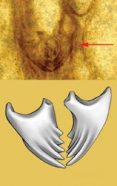Winged insects may go way back
A fossil's mouthparts hint that winged insects lived on Earth 400 million years ago.
Share this:
- Share via email (Opens in new window) Email
- Click to share on Facebook (Opens in new window) Facebook
- Click to share on X (Opens in new window) X
- Click to share on Pinterest (Opens in new window) Pinterest
- Click to share on Reddit (Opens in new window) Reddit
- Share to Google Classroom (Opens in new window) Google Classroom
- Click to print (Opens in new window) Print
By Emily Sohn
A bug may seem creepy, annoying, or cool, depending on its size and your mood. Now you might want to show these critters a little more respect, too. Bugs have been around on Earth for a long, long time.
A new analysis of an ancient fossil suggests that the first winged insects lived as early as 400 million years ago. That’s tens of millions of years earlier than scientists used to think.
 |
|
The mouthparts (arrow and bottom) of a 400-million-year-old fossil hint that the creature was a winged insect.
|
| David Grimaldi/Columbia University Press |
The fossil, a piece of an insect’s tiny head, was found in Scotland. Scientists looked at it briefly in the late 1920s and named the insect Rhyniognatha hirsti. Soon after, everyone forgot about the fossil. Until now.
Two researchers, one from the American Museum of Natural History in New York and the other from the University of Kansas in Lawrence, noticed that the insect has a striking mouth. Its chewing mouthparts are strong and triangular, with toothlike projections. Each jaw, which measures just 0.1 millimeter across, has a special type of hinge.
Rhyniognatha‘s jaws are similar to those of many modern winged insects, including dragonflies. Unfortunately, the rest of the insect’s body was lost, so researchers can’t tell for sure if it had wings or not. They also can’t tell if Rhyniognatha lived in water or on land and whether the fossil is that of an adult insect or a larva.
Still, it’s clear that today’s insects have ancient ancestors. Bugs have been around a lot longer than people have.







